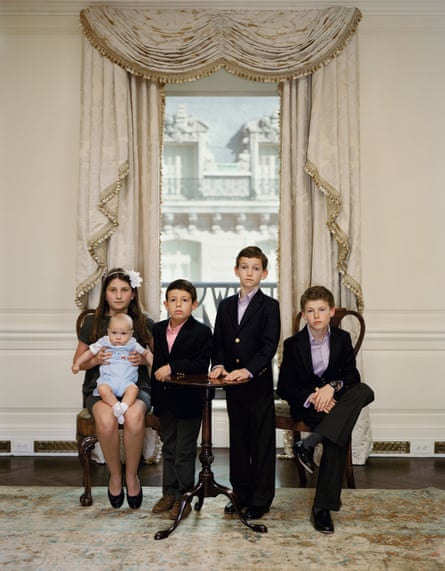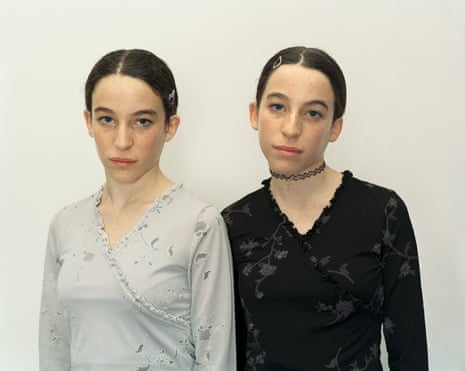Five figures pose in preppy clothes for a family portrait in their Upper East Side apartment. Polished parquet, Persian carpets, elegant curtains framing a view of the equally expensive real estate opposite: the photograph is luxuriously detailed and vast. But the subjects are deeply disturbing. For instead of adults, they turn out to be children adopting the fixed and formal attitudes of their elders. Even the baby appears old. But is it by nature, habit or instruction?
It is more than a decade since Rineke Dijkstra’s last major show in this country – far too many years. Now the Marian Goodman Gallery – one of very few London dealers reopening this week, way ahead of the museums, that isn’t mainly selling stock by private appointment – has mounted a world-class exhibition. Dijkstra fills room after room with her visions of lone children, siblings, teenagers, twins. It would be hard to think of a more humane and attentive portrayer of youth.
The Dutch photographer (born 1959) made her name in the 90s with seashore portraits of adolescents posing in their swimsuits like awkward Botticellis. These were accompanied by videos of teenage clubbers in Liverpool and Zaandam in the Netherlands; comic yet poignant. Dijkstra’s work has grown steadily stronger in empathy and observation ever since.
Here are huge images of small girls from Dijkstra’s long-running Parks series. A child with a skipping rope fills the frame, in Madrid’s El Retiro, dignified as a Velázquez despite the fussy Sunday dress she must rise above. Another balances on a small scooter, purposefully upright in the slack leisure park around her. Dijkstra raises her slightly on a mound, so that we must look up to this little girl. It is exactly the kind of photograph most of us never take: a singling out so strong that the child’s strength of purpose, in both hand and eye, becomes almost heroic.
In Israel, teenage twins Chen and Efrat are photographed every March for seven years. The changes are both small and enormous. Braces, clumsy eyeliner, adolescent halternecks; a growing and then a fading sullenness; a difference of opinion about being photographed, about being sisters, about being nearly identical. The smallest tensions register, even through the narrative of their hair. At first it is long and carefully brushed by their mother; then it is braided, scraped back, waved, styled, as it becomes their own possession – and as the sisters come into their own. The infinitesimal differences in their features are so tenderly observed by Dijkstra, and her viewers in turn, that the evolution of one girl’s fractionally greater beauty is something one tries hard not to notice.

Sometimes it seems as if one is looking at two sisters, with the nagging thought that one is strangely older and might possibly be the other’s mother. Who is trying to imitate whom? Or a couple of siblings appear oddly oversized for their surroundings, seated on furniture too small to hold their full force of personality, like a scene from Alice in Wonderland. Faces don’t fit bodies; clothes don’t match expressions. Perhaps this is what it is to be almost adult, but still living at home with your parents.
Dijkstra is always contemplating the central paradox of portraiture – that we are not our faces, and yet are depicted thereby. She notices every slippery mismatch, every uneasy recoil, the turning away, the self-conscious covering of a hand or cheek, along with the candid openness of these young people to her lens. Each portrait testifies to the patience and trust achieved between the sitter and the artist, her four by five inch analogue camera mounted on a tripod, sometimes accompanied by a flash.
In London, young dark-eyed twins perch together on a chair before a window. They are dressed so differently – one in a classic school uniform, with shirt and tie; the other with lustrous long hair and a black T-shirt – that it almost seems as if they are brother and sister. You have to look extremely carefully at this photograph, and these faces, to discover that they are both boys. But the lucid detail of each photograph abets it, and by then Dijkstra has caused you to think hard about our times, and our children, and how they will choose to live in this changing world.
The fine hair on an arm, a mole that fades over time, a gap tooth, a broken nail, the ordeal of folding long legs on a sofa: the scenes look so natural and effortless; and as if the artist had a special eye for intriguing sitters. But she works patiently to notice every singularity. Her concentration is never patronising, always curious and compassionate. A brother and sister in a scrubbed Ikea kitchen: she stands, he sits gigantic in a too small chair. If he stood up, this boy would dominate room, scene and sibling.

Curiosity, honesty, extreme attentiveness: Djikstra’s crowning characteristics become the subject of a three-screen video installation at the heart of this show. Night Watching was filmed in the Rijksmuseum in Amsterdam, at night. It shows different groups of people looking at Rembrandt’s The Night Watch (offstage) and reacting with compelling candour.
Dutch girls wonder whether the only woman in the painting has the face of Rembrandt’s wife, Saskia, whether and how these hulking men ever washed. Boys joke about the blurriness of the dog (probably because he’s the only sitter who didn’t pay). Japanese businessmen weigh up the picture’s tourism potential. Painters discuss the quality of the light and the way Rembrandt mixed his pigments. A group of Dutch bankers are amazed to discover that the nation’s masterpiece was actually painted by day, and has an entirely different name, now that it has been cleaned. A group of female friends debate the ultimate value of a painting about men and their clubs as compared to Vermeer’s paintings of women getting on with their labour.
How people look at Rembrandt, why they love him, how art fuses with our lives: Dijkstra lets our fellow men and women speak for themselves. They become a human company easily as enthralling as the one painted by Rembrandt. The film is only half an hour long. I could have watched it for ever.

Comments (…)
Sign in or create your Guardian account to join the discussion